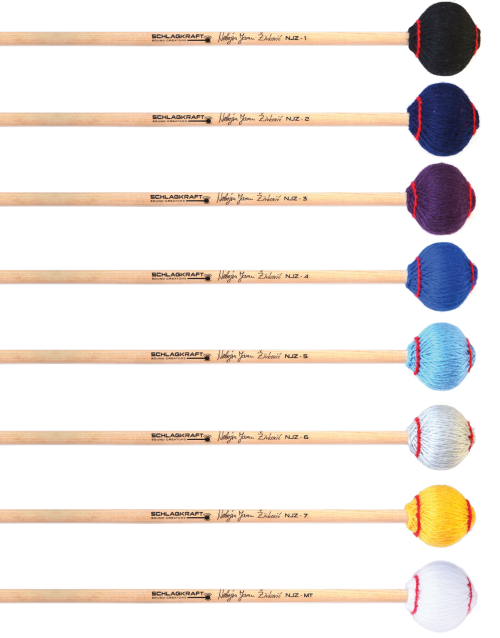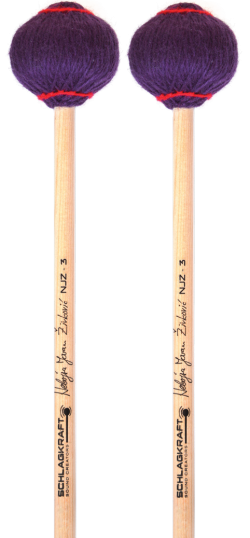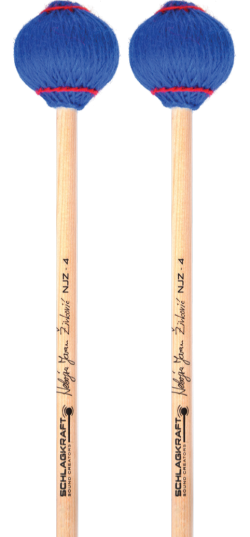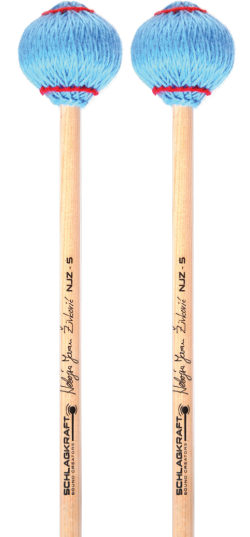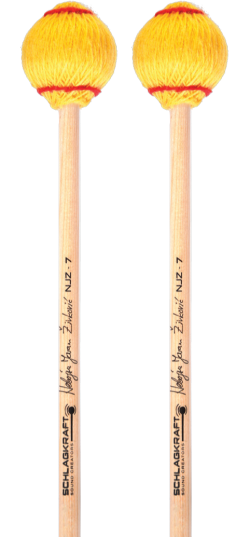Nebojša Jovan Živković
Signature Series
Legendary Nebojša Jovan Živković Signature Series
Marimba Mallets by SchlagKraft master mallets maker!
Made with pride and knowledge in Europe by SchlagKraft, in perfected superior quality.
Over 30 years of performing experience and many years of intensive material and sound research have resulted in these unique high quality Zivkovic professional mallets. Eight models to choose from, separated in three sound groups, with artists idea of sound in mind. We use different hardness rubber cores and wrap them in order-made layers of various materials. Available on hand-selected, elasticity tested larger diameter cedar OR stronger, superior quality rattan handles. Wrapped in synthetic-blend yarn that is extremely durable with excellent behavior in contact with marimba bars. Zivkovic Series mallets can be sorted in three sound groups:
Group one: Mallets #1 & #2 that clear but tender in soft low register, with “earthy” sound perfect in weight and balance, this mallet WILL make any low bar ring and resonance
Group two: General performing models (mallets #3, #4, & #5) those are strong in projection, never too harsh, with ideal coverage of entire range of te 5 octave instruments
Group three: Mallets #6 and #7. constructed for strong sharp cut through the orchestra, clear projection and stil bringing out that big strong fundamentals
NJZ-1 Earthy Black
NJZ-2 Ocean Deep Blue
NJZ-3 Lilac Tender General
NJZ-4 Blue Strong General
NJZ-5 Sky Blue General Clear Cut
NJZ-6 Silver Sharp
NJZ-7 Canary Cut Through
NJZ-MT Sky white
Nebojsa About His Mallets
The marimba sound I am looking for could be described as clear, very sensitive, in most cases slightly sharp rather than too cloudy (moody), but never harsh or hurting. Also, even in the softest pianissimo (even with the softer mallet), one should be able to get a clear attack, to hear a distinct beginning of the vibrating bar, with almost no contact sound between the mallet head and wooden bar.
At the same time, in order to get rich fundamentals, especially from the LOWER register of the marimba, where the bars are rather big, we need to have mallets with certain weight and length. (weight and length are the things responsible for what is later called “good balance” or “good feel”). Having a certain MINIMUM weight, the mallet will almost “alone” be able to get a rich sound from the instrument, and there will be no need to spend any extra energy by the performer (in terms of stroke).
This “size & weight thing” however, can not be endless, since the mallet will simply become too heavy and large. With such mallets we hardly are able to perform anything but rolls or slow easy lines of single notes.
On the other hand, I also need a mallet that is strong and powerful enough to CUT THROUGH the full symphony orchestra in marimba concertos, even if the orchestration is rather “thick”. It is a challenge to get mallets that are HEAVY enough to help produce a FULL, RICH sound – yet at the same time are LIGHT enough (and well balanced), so that fast runs, virtuoso passages and fast interval changes are playable.
So, the ideal combination of HEAD SIZE, SHAPE and WEIGHT, shaft LENGTH, and additional layers and wrapping (material, layers and tension of the wraps) FOR EACH MODEL AND HARDNESS had to be found, while always keeping in mind what the MOST COMMON USE of each specific mallet will be.

